The Caribbean Islands, also called the West Indies, have many names that confuse me. Anguilla and Antigua, as well as Barbuda and Barbados, are names that sound alike but are far afield from each other. Saba Island is not the bar in the BVI known as Saba Rock. There is more than one Georgetown, and a couple of Marigot Bays, so you might want to keep your chartplotter on during shoreside conversations with other cruisers. We visited Saint Martin, or was it Sint Maarten? Those similar names are the French and Dutch names for parts of the same island. The island was sawed in half in 1648 and controlled as colonies of Holland and France. The Dutch got a smaller portion, but with more productive salt ponds.
Today, St. Maarten has the lowest import duties in the Caribbean and has become a hub for boat repair. It also offers sailors plenty of cheap booze, large docks for mega-yachts and other activities outside the coverage of this blog. It has car dealerships, malls, box stores, Ace hardware and small traffic jams. In St Maarten’s major bay (Simpson) you are never far away from a night club’s thumping bass. Two Fish went there for the flat water of the lagoon and to buy a few spare parts.
- Gail returning with laundry
- Marina fountain
- Steps up to the restaurant square
- Two Fish in Mega Yacht Slip
We docked the boat in the Cupecoy Marina, deep into the Lagoon. The marina offers a deluxe service in which a pilot boat greets you at the bridge and guides you into the marina. The service is more appropriate for mega-yachts, but we enjoyed the over-the-top service for our little boat. Docking there is tricky in a strong breeze and the very competent port captain, Guy, helps some owners park their boats. We enjoyed his dinghy-as-bow-thruster service as an extra precaution. The marina is not sheltered. Instead it is at the end of a wind funnel creating discomfort in the outside visiting slips during strong trade winds. However, shore side life in the complex was very comfortable. Huge pool, nice gym, a great French supermarket and friendly live-aboards made our stay wonderful. The marina would be considered rural St. Maarten; we were happy to be away from the tacky night clubs. We chose the marina rather than anchoring to make it easier to work on the boat. But first, it was off to have some fun.
The must do thing on the island is to put you self in harms way near planes taking off and landing. The runway abuts a beach and thrill seekers hang on to the airport fence while receiving a jet blast. We timed our visit to enjoy the largest landing, a KLM widebody. I found the experience underwhelming but it was a fun way to spend an hour. The area was a complete zoo as the cruise ships had exported their cargo, the hotels had shuttled their guests, and a few wayward cruisers added themselves to the mix. There are clearly more people watching the planes than using the airport.
We explored Marigot Bay, in the heart of the French side of the island. The wind, which I will complain about a few times in this post, was hooting for our entire visit. Twenty-two knots most of the time, with puffs over thirty. We have had these persistent trade winds since before our departure from the BVI. We thought Marigot Bay might be calmer, but monohulls and catamarans were sailing on their anchor chains. The random puffs coming down the hill would push them askew from the prevailing wind. Then the uncomfortable process of equalization would occur. We watched this tiring battle from a café before beginning our ascent of the local fort. This fort stopped the English from stealing French goods in St Martin. The commandant boasted that not one single French coffee bean was stolen after the fort was constructed. I often wonder how different this region would have been if the Europeans had arrived after the abolishment of slavery and the industrialization of agriculture. We will never know.
- Heavy winds and Gail’s hair #109
- Obsessed with sign posts
- Pensive Captain
- Sun warms the Eglise
- St Martin shopping
Gail’s trusty watch finally died from excessive salt water inhalation. The glow-in-the-dark Timex with cloth band had served her well. So we went to the mall. We had not seen a mall since Florida. The Blue Mall seemed like a project that was destined to fail. It is four stories of modern mall with enough foot traffic to keep a small bodega in business. We did our part to keep the mall open by buying a Swatch and a running shirt. We learned later that cab drivers are paid 2 dollars per passenger they drop off at the mall. We had walked.
- Friends scampering up
- Classic peak photo
- Sugar Mill remains
While there, we met some new friends who were on a Voyager brand catamaran. I marvel at these boats since they have a bar that extends from the aft portion on the boom for raising the dinghy. I suppose you learn to trust the construction but I prefer our traditional dinghy arch. The four of us decided to visit Loterie Farm, which charges 5 euros to go for a hike on the property. The goal of the hike is to visit a cell phone tower situated at a local geographic maximum. Caribbean hikes offer many views of radio, microwave and cell phone towers. The hike was a bit below average in terms of beauty, which matched our opinion of much of St Martin. We liked it, but did not love it.
St. Martin has two drawbridges, which is unusual since the rest of the Caribbean has about zero. Some charts don’t yet show the second one in the middle of the bay so it is good to keep your eyes open. After 18 months, we are no longer complete rookies. Our Inter Coastal Waterway experience gave us plenty of drawbridge practice, so we passed through like pros, usually the foundation for an upcoming monumental mistake. Ten days later, while leaving St Martin, we saw a charter cat floundering as it exited. We were following behind her closely and the bridge operator sent out a boat to scold her for transiting too slowly. This only slowed her further. The captain was propelling the boat at drift speed close to the leeward side of the bridge, causing me to assume he would bump the bridge. But luck was on the charter boat’s side, as the breeze stayed calm while the bridge operator boiled over.
- Phaedo3
- My other boat is an Antares
- Close pass of Two Fish during race
- Another Antares : True North
The Heineken Regatta, one of the big Caribbean sailing events, took place during our stay. Kool and the Gang flew in from the USA as the featured band for the party. This headliner was not enough to have us leave the cocoon of our marina compound. Instead we opted for outdoor movie night.
We did see Phaedo 3 race by us going faster than the cars on the island. Her top speed for the race was 38 knots. Imagine if Two Fish traveled at that speed; overnight passages would be over in 3 hours.
We left St Martin on the last day of racing and I enjoyed threading through the fleet to reach St Barts. The low point of the visit was a customs official with a tip jar. How is that possible? However, I think I gave St Maarten a bum rap because the wind made life aboard in the wind tunnel marina a bit annoying.
Skills builder
We are always experimenting and learning about securing Two Fish in a Marina. Marinas are tougher than anchorages since the boat is prevented from floating naturally and there are plenty of fiberglass eating surfaces. Here are some of the basics we have learned
- Tying up Two Fish
- Fenders + Many spring lines
- Skipped chock
- Winch allows for warping
1 ) Two Fish is never tied up with fewer than 4 dock lines. A stern line, a mid to stern spring, a mid to bow spring and a bow line. The spring lines retard fore and aft movements while the bow and stern retard the boat turning.
2) Gentle line angles and longer lines will reduce the load on the boats chocks and cleats. The boat has ten cleats offering a myriad of clever ways to tie up the boat. In the strong breeze in St. Martin, we had two bow lines. The bow farther from the dock was set to hold much of the load.
3) Winches make great cleats. Often we may wish to get the stern close for loading on provisions. But later, we ease the line to allow the boat to float more naturally away from the dock. Instead of cleating, we just leave it on the winch.
4) Fenders can be hung vertically by one line or horizontally by two lines. The latter is key if the dock has pilings protruding into the slip.
5) In tidal places the length of all dock lines should be 3 times the tide height.
Here is the rundown of our boat labor. Stop reading now if you like the travel stuff but find the technical boat stuff a bit boring. Be honest-do you think I can drone on about boat things?
Job#1: Fix bridle
The Antares has a great bridle which is permanently fixed at the water line. While in Aguilla, I (Jason), installed the bridle with twist. After 6 hours in a stiff breeze, the bridle ate itself and failed. (click here to read post) The boat stayed on location, but was held by the anchor lock. This put us in the market for a new bridle. One could say we were motivated buyers. We did not choose to splice our own and hired the services of FKG marine. We followed our typical rule. If anything breaks, buy two, one to replace and one as a spare. In this case our spare is designed to be operated at deck level for flexibility. We have decided that when leaving the boat at anchor in a strong breeze we will deploy both bridles. The deck bridle is superior when you wish to make adjustments for particular conditions. (Short bridle for shallow anchorages where the bridle is being rubbed on the seabed and a skewed bridle for swell coming for a direction other than head to wind.)
As an aside the guy next to Gail was ordering 25,000 dollars worth of work for his boat but he had to wait for us to finish up our 100 dollar order.
Job #2: Replace raw water pump
- Gear Extractor for pump change
- Well named book at chandlery
- Our engine type airborne
- Where sail drives go to die
We have 1,000 hours on our engines and the raw water pump bearings had started to fail, allowing a small amount of sea water to enter the bilge. We were extravagant and installed new pumps rather than rebuild the old ones. We will now rebuild the old pumps and keep them as spares. Remember the Two Fish rule: buy two. When picking up our spare parts from the local dealer we noticed that the entire shop floor was covered with broken sail drives. We consider ourselves lucky not to have sail drives. It is also worthwhile to have a gear extractor when changing out the raw water pump. Supposedly, you can buy a 100 mm at any auto parts store.

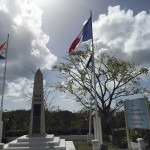
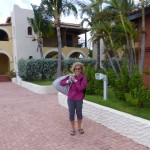
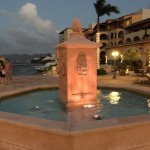
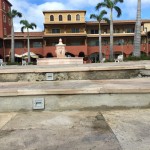
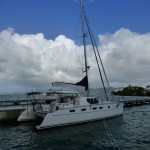


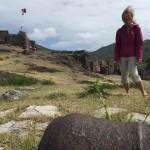
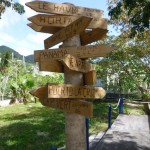
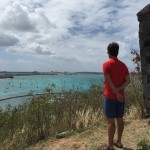
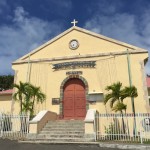
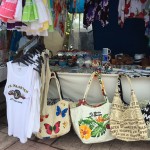
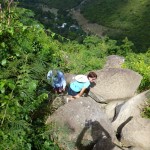
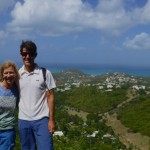
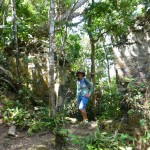
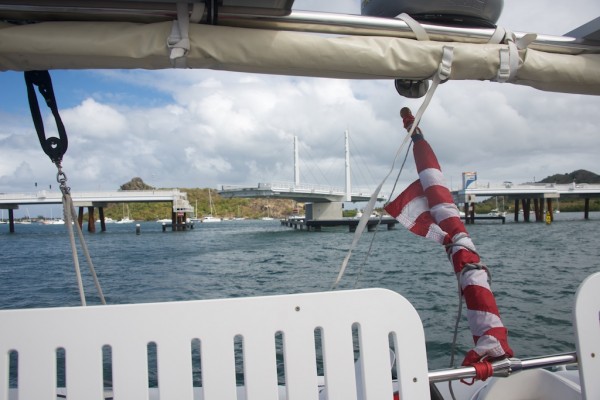
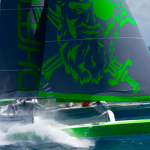
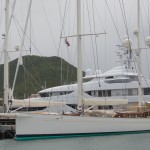
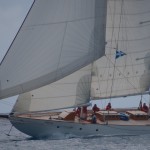
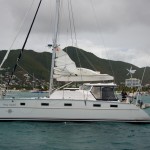
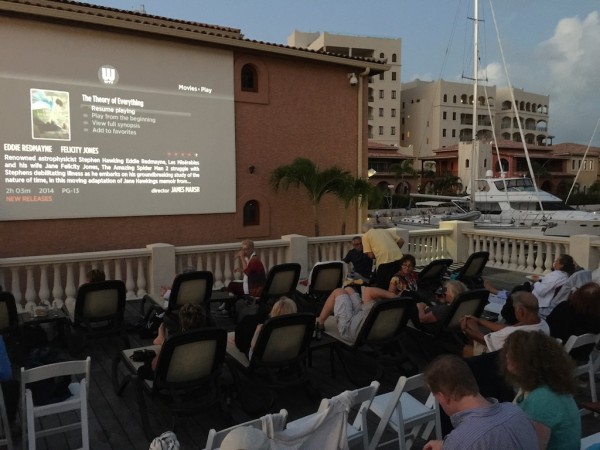
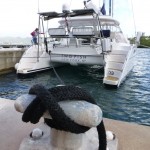
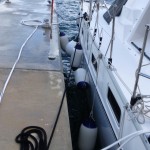

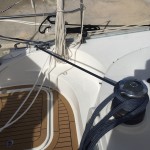
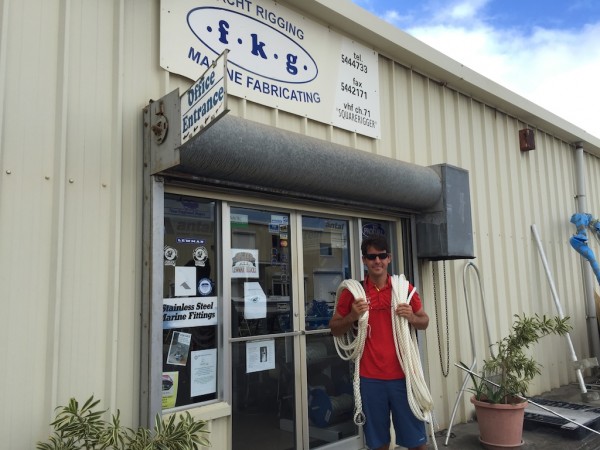
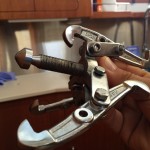

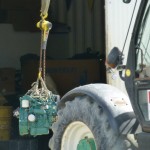
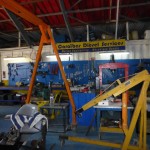
2 Responses to St. Martin – St Maarten